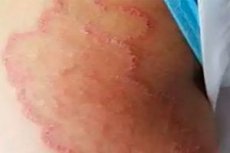Inguinal epidermophytosis
Last reviewed: 23.04.2024

All iLive content is medically reviewed or fact checked to ensure as much factual accuracy as possible.
We have strict sourcing guidelines and only link to reputable media sites, academic research institutions and, whenever possible, medically peer reviewed studies. Note that the numbers in parentheses ([1], [2], etc.) are clickable links to these studies.
If you feel that any of our content is inaccurate, out-of-date, or otherwise questionable, please select it and press Ctrl + Enter.

Causes of the inguinal epidermophytes
The causative agent of this fungal infection is Epidermophyton floccosum, less often - Trichophyton rubrum, Trichophyton mentagraphytes.
Infection of the inguinal region occurs in patients with foot dermatophyte, as well as through household items used by the patient (oilcloth, bast, linen). Risk factors are a hot humid climate, tight trousers, obesity, prolonged treatment with corticosteroids for external use.

Symptoms of the inguinal epidermophytes
The process is usually localized in the inguinal folds, but can also occur in other areas of the skin (bugular, under the mammary glands). The disease is characterized by acute inflammatory symmetrical eruptions, prone to peripheral growth. Foci of lesion are round spots of red-brown color, polycyclic outlines. The focal zone of the hearth, covered with vesicles, pustules, erosions, scales and crusts, in the form of a continuous cushion, will stand above the surrounding skin. The process is usually accompanied by severe itching, sometimes painful.
Inguinal epidermophytosis proceeds chronically, exacerbated by the action of irritating factors (eg, sweating) during the hot season.
 [4]
[4]
What do need to examine?
How to examine?
Who to contact?
Treatment of the inguinal epidermophytes
In the acute period, lotions from 0.25% silver citrate solution, 1% resorcinol solution, hypo-sensitizing, antihistamines are prescribed.
Of the local antimycotics, zalain, lamizil, clotrimazole, pizoral, etc. Are used. In case of ineffectiveness of external agents, lamizil is prescribed (250 mg / day for 14 days), itraconazole (200 mg / day for 7 days).

